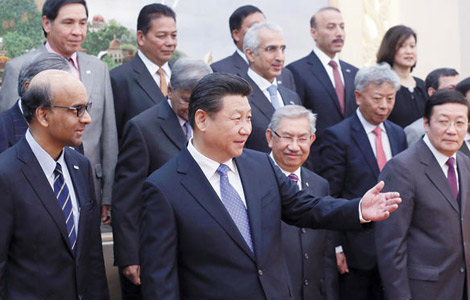Steel exports unlikely to strain Sino-Latin American bond: Analyst
Updated: 2014-10-25 22:10
By PAUL WELITZKIN in New York(China Daily USA)
|
||||||||
Rising steel exports from China into Latin America may slightly increase tensions between the region and the world's second-largest economy, but shouldn't have a major affect on the relationship, according to an analyst.
Alacero, or the Latin American Steel Association said last month that steel imports from China jumped 60 percent year-over-year in the first seven months of 2014. The trade group said Brazil, Chile and Central America were the main destinations for Chinese steel, but imports to Mexico are also rising rapidly. It urged a government response to the Chinese imports.
"Given this issue, it becomes imperative that the governments of the region react timely and effectively by accepting the investigations presented by the industry and by developing public policies to address this type of unfair imports," Santiago-based Alacero said in a statement last month.
Margaret Myers, director of the China-Latin American program at the Inter-American Dialogue, a Washington-based think tank, said the increase in steel exports to Latin America reflects China's steel industry in transition.
"China's steel industry, which is a major employer in the country, is plagued by overproduction and inefficiency," she told China Daily. "While steel imports have been increasing and may have shaken things up a bit, as far as the China-Latin American relationship is concerned, I don't think it will become a major issue between the two sides. As China continues to reform its economy and industries like steel, I think this will take on less significance."
In 2013, Mexico imposed tariffs on seamless steel tubes from China after a Mexican steel company complained about unfair pricing practices.
Myers said there could be several reasons for the jump in Chinese exports to Latin America in the first half of 2014. "Some of this could be for Chinese projects in the region. Some of it may also be tied to increased infrastructure demand from the World Cup (soccer tournament) Brazil hosted this year and the 2016 summer Olympics (also scheduled for Brazil)," she said.
Myers said the economic ties between China and Latin America, which have been increasing sharply, are still on track to expand even more as China appears poised to announce a major infrastructure fund for Latin America and especially Mexico at next month's Asia-Pacific Economic Cooperation (APEC) meeting in Beijing.
"In November, China will announce an infrastructure fund targeting the region and especially Mexico. China is expected to work closely with Pemex (Mexico's State-owned oil company) to help build out the industry. I am also hearing talk that next month China and CELAC (Community of Latin American and
Caribbean States) are set to announce an initiative that will consolidate several existing lines of credit related to infrastructure development in the region. More infrastructure development will likely mean an increase in demand for products from China," she said.
It is important to understand the relationship between China and Latin America, especially when it comes to steel and the metals industry, according to Myers.
"Latin America is important to China as a source of minerals that the Chinese can convert into products like steel. Latin America is not a major export market for China although that could begin to change in the long term," she said.
paulwelitzkin@chinadailyusa.com

 Accord reached on key bank
Accord reached on key bank
 Remembrance of Flying Tigers & WWII Veterans
Remembrance of Flying Tigers & WWII Veterans
 Lang Lang plays at the UN Day concert
Lang Lang plays at the UN Day concert
 Politicians don't let minor injuries stop them
Politicians don't let minor injuries stop them
 iPhone loses subsidies in China
iPhone loses subsidies in China
 Shanghai travels to Texas
Shanghai travels to Texas
 In California: Cash, Cash, Cash
In California: Cash, Cash, Cash
 Concert with Chinese pianist helps UN celebrate anniversary
Concert with Chinese pianist helps UN celebrate anniversary
Most Viewed
Editor's Picks

|

|

|

|

|

|
Today's Top News
China to provide the 4th batch of assistance to fight ebola
China's 361 will make uniforms for Rio 2016 Olympic Games
China's tie with Latin America expands to security
Steel exports unlikely to strain Sino-Latin American bond: Analyst
Concert with Chinese pianist helps UN celebrate anniversary
Accord reached on Asia infrastructure bank
Civil service exam hit amid corruption crackdown
'Miracle' premature baby ready to go home
US Weekly

|

|







